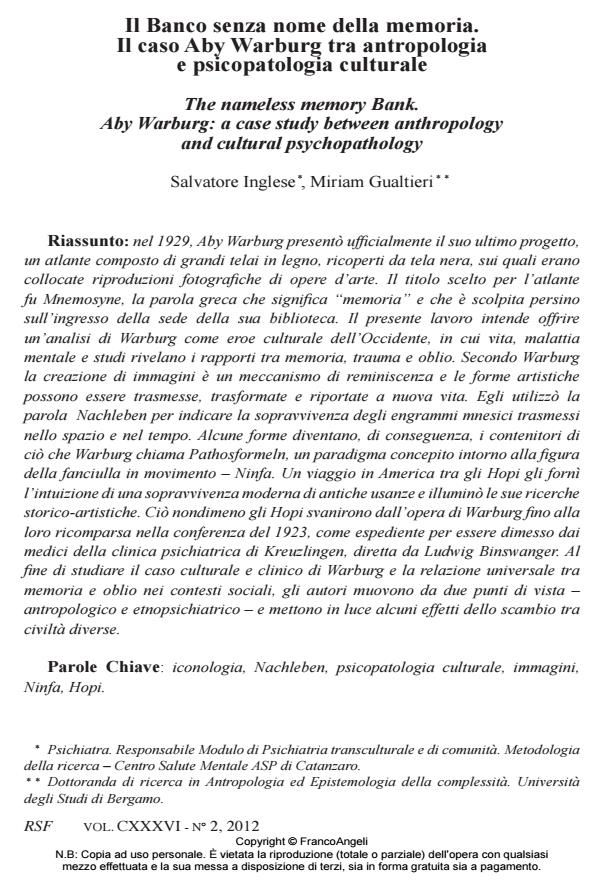The nameless memory Bank. Aby Warburg: a case study between anthropology and cultural psychopathology
Journal title RIVISTA SPERIMENTALE DI FRENIATRIA
Author/s Salvatore Inglese, Miriam Gualtieri
Publishing Year 2012 Issue 2012/2
Language Italian Pages 22 P. 17-38 File size 1668 KB
DOI 10.3280/RSF2012-002002
DOI is like a bar code for intellectual property: to have more infomation
click here
Below, you can see the article first page
If you want to buy this article in PDF format, you can do it, following the instructions to buy download credits

FrancoAngeli is member of Publishers International Linking Association, Inc (PILA), a not-for-profit association which run the CrossRef service enabling links to and from online scholarly content.
The article examines through two different approaches - anthropological and ethnopsychiatric - the cultural and clinical case study of Aby Warburg. The universal relationship between memory and oblivion, present in different social contexts, is highlighted and particular outcomes produced by exchanges between civilizations are underlined. In 1929, Warburg presented his atlas made of large wooden frames covered with black linen and photographic reproductions of artworks. The title of his atlas Mnemosyne is the Greek word for "memory". This word hangs also over the door of his library. Warburg is a cultural hero of the Western world. His life, mental illness and studies illustrate the connections between memory, trauma and oblivion. In his studies, Warburg suggests that the mechanism of reminiscence creates images. Thanks to these images artistic forms can be transmitted, transformed and restored to a new life. He also points out the endurance of mnestic engrams through space and time using the term Nachleben. Some artistic forms thus become containers, labeled by Warburg Pathosformeln, a paradigm recalling a maiden in motion: the Nymph. A journey to America and a visit to the Hopi provide him with the insight of the present-day survival of ancient practices. This finding grounds his research in the history of art. However, the Hopi theme disappears from his work only to reappear years later in a lecture he gave in 1923, when he sought to be released from the Kreuzlingen psychiatric clinic directed by Ludwig Binswanger.
Keywords: Iconology, Nachleben, cultural psychopathology, images, Nymph, Hopi
Salvatore Inglese, Miriam Gualtieri, Il Banco senza nome della memoria. Il caso Aby Warburg tra antropologia e psicopatologia culturale in "RIVISTA SPERIMENTALE DI FRENIATRIA" 2/2012, pp 17-38, DOI: 10.3280/RSF2012-002002